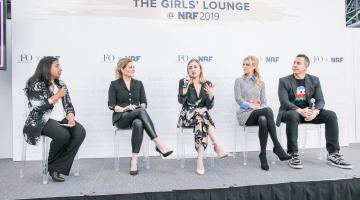
The statistics tell the story: 85 percent of all purchasing decisions are influenced by women but 40 percent of those same influencers don’t see themselves reflected in today’s brand messaging and advertising. That’s a missed opportunity for marketers and advertisers, according to a panel of thought leaders at NRF 2019: Retail’s Big Show.
“How marketing can advance equality,” moderated by “Today Show” Correspondent and Tesoro Collective co-founder Lilliana Vazquez, featured Knix founder and CEO Joanna Griffiths, FULLBEAUTY Brands Chief Customer Officer Liz White and FitForCommerce CEO Bernadine Wu talking about how they make sure their brands’ messaging is inclusive and equality fit.
“If equality were easy to achieve, everyone would be doing it and better yet, everyone would be doing it really, really well.”
Lilliana Vazquez, Tesoro Collective
Vazquez kicked off the discussion by addressing what she called the elephant in the room. “If equality were easy to achieve, everyone would be doing it and better yet, everyone would be doing it really, really well,” she said. “Why is it not easy for brands to get it?”
As the head of a digital strategy consulting firm, Wu said she often sees companies that are great at messaging to an audience of women. The tricky part is making sure that female voice is represented inside the company and its management: If company leaders really want to change that dynamic, it must come from within. “It can’t change through wishful thinking,” Wu said, “we have to get tactical and strategic.” She mentioned actress Regina King’s recent pledge to work with and hire more women during her Golden Globes speech. “We have to make those pledges in order to get there.”
Authenticity at the forefront
For intimate apparel company Knix, the best first step for any brand that wants to promote equality is to make sure their marketing and advertising represents their customer. “For a really long time, marketing and advertising lived in this world of what’s aspirational. And for many brands, there was this viewpoint of what aspirational looked like, especially in the intimate apparel industry,” Griffiths said.
“Now you’re seeing a shift where people are valuing what’s authentic and what’s relatable. It’s changing the mindset of what’s aspirational.”
Joanna Griffiths, Knix
Change is coming, she noted, thanks in part to the larger role that social media plays in the retail landscape. “Now you’re seeing a shift where people are valuing what’s authentic and what’s relatable. It’s changing the mindset of what’s aspirational.”
White agreed that it can make a difference, even in a legacy company, to reorient marketing and advertising “around the customer.” FULLBEAUTY Brands is a 120-year-old company that has a history of serving plus-size customers. That customer looked very different in 1901, White said, and when the company began reorienting its strategy to reflect and serve its “true customer” last year, leadership realized she was a 58-year-old, size 22 woman making $50,000 a year. When White and her team looked for photos and images that portrayed that customer for their marketing and advertising, though, they came up blank and began creating those images themselves.
Knix has done something similar, casting real women and real customers in their photo shoots and advertising campaigns since 2013. “We’ve worked with over 600 of our customers and by actually going to real customers and starring them in our campaigns, it feels a lot more genuine and less stereotypical,” Griffiths said. “They also become great brand ambassadors.”
Pushing for change: What brands can do
“If you want to be inclusive, you have to be explicit about doing that. We can’t be afraid to be explicit about our inclusion effort.”
Liz White, FULLBEAUTY Brands
Brands that want to push for more accurate representation should consider tapping directly into their customer base and giving them a platform to promote your brand. “I encourage putting user-generated content on product detail pages, including self-loading images,” Wu said. “Then you’ll get the authenticity of your customer. If you open the doors and let your customers speak for themselves, then they will show themselves.”
White said she makes sure FULLBEAUTY Brands chooses and works specifically with partners based with alignment on message, including creative agencies that are owned or led by women. At the end of the day, ensuring equality in brand messaging and advertising is an all-in, inclusive effort. She subscribes to an approach from Pipeline Angels’ CEO Natalia Oberti Noguera: If you want to be inclusive, be explicit. “We can’t be afraid to be explicit about our inclusion effort,” White said.
Relive all the highlights from NRF 2019: Retail’s Big Show, including sessions, photos and videos in the official show recap.

